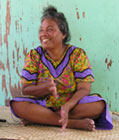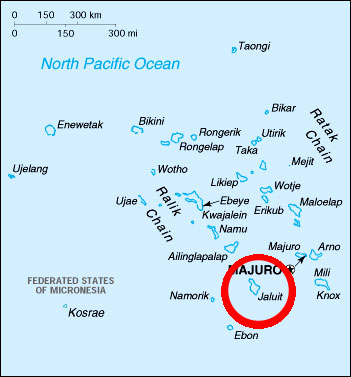




Transcript of Murder Inquest,
Jaluit Atoll, Marshall Islands,
Tuesday, October 9, 1945

Introduction
The following is a transcript of an inquest into the murder of eight Marshallese by the Japanese military in 1945. One of these victims was the mother of Senator Chuji Chutaro, who made this transcript available.
At the time of the murders, the Japanese were beseiged by American forces, which had encircled the Japanese-occupied islands of the Marshalls. As a result of the seige, both the Japanese and the Marshallese were starving. Desperate, many Marshallese attempted to esape their captors. The Japanese military was adamant in its imposition of discipline on the Marshallese, as the transcript makes clear.
A major Japanese naval base during World War II, Jaluit suffered extensive bombing by the American forces. The Japanese garrison of approximately 2,000 men did not surrender until Sepetember 1945, after three years of bombing and a protracted seige.
TESTIMONY OF: Fumio Inoue [Japanese Officer]
1. Q. State your name, rank, and present station.
A. Fumio Inoue, Captain, Imperial Japanese Army, attached to the headquarters of the First South Sea Detachment, Jaluit Atoll.
2. Q. Did you work under Major Furuki or for the Navy?
A. I worked under Major Furuki.
3. Q. Tell all you know about the execution of the eight natives who were captured April 1945, their capture and all the things leading up to it.
About six months have elapsed, so I might have the dates and the names of the natives mixed up, but I will give you the story of it. At that time I was the Naval Police Commander. My duties were to check on the civilians and Navy and Army personnel from not eating more than they were allowed to. About the end of March this year there were reports to the headquarters that four natives had drifted down to Jaluit. On the following day we had a report that four other natives had also landed on the island north of Medyai.
At that time Warrant Officer Omura on Jaluit Island and First Lieutenant Furuno on Shittogen Island notified that the natives had drifted over here. Headquarters had me check on the eight natives because they thought the natives were sent here by the Americans to make some scheme to get the other natives off. Therefore, the eight natives were sent to the headquarters. At that time these natives were sent to the headquarters they didn’t have any particular person in charge to look after the natives in native cases so the Admiral ordered me (Captain Inoue) (then in charge of the Naval Police and the civilians and Army and Natives) to investigate these natives. On this atoll here the Army and Navy got along very harmoniously so whatever we did, we had full cooperation among the units, the Naval Police were composed of Army and Navy personnel.
I was the commander of the Navy and the Army Police. The natives that were brought from Jaluit were kept on Ainama and the other four were kept at the ammunition dump on Emidg. .I and First Lieutenant Morikawa, intelligence officer, and Shiroshita, civilian interpreter, the three of us interrogated these eight natives. I first asked this question, “Why did you desert Mille?” The native replied, “Because many of the other natives were being rescued by the other American ships and we had heard an order by the commander of Mille that if any more natives tried to escape or escaped that all the natives left on Mille would be executed; so we made up our minds to take a chance in trying to get picked up by an American ship or drift to Majuro. The four on Shittogen and the four on Jalulit had conferred with each other before they left Mille.
4. Q. What kind of boats did they come in?
A. The four natives who landed on Jaluit escaped on a Japanese new boat that holds about ten men and the other four escaped on a native canoe and the canoe was supposed to tow the Japanese boat because the canoe had the sail and the other boat only had to be towed, it had no power. The Japanese boat was stolen by one of the natives on Mille on Takawa Island. The natives used to transport food from the other islands. Rarime was the native. This native with Tanaka used to bring food to the islands with the other boat. They talked it over with others and Rarime and another native killed Tanaka and kept the boat. During the interrogation we interrogated them individually. There were four men, two women, and two children about ten years old, one boy and one girl. All of them said that Rarime had killed Tanaka so that they could take the boat.
5. Q Do you have nay proof of that?
A. On the boat we found Chief Petty Officer Tanaka’s clothes, his towel, and other things with his name on them. At that time we thought of notifying the Lt. Com. from Mille to verify the story but even the ten year old child was saying the same thing as the adults, so it must have been true. Even today if you make an inquiry at Mille about Tanaka they should have a record of it, that between the 20th and of March Tanaka had disappeared somewhere in the lagoon. The eight natives on the way here were picked up by an [American] LCI before they landed here. At that time when they were rescued by one of the LCIs they were told to go to Jaluit to let the natives know on Jaluit what was happening at Mille and to tell all the natives on Jaluit to escaped when the LCI came and for the eight natives to escape with the natives on Jaluit.
6. Q You claim that the eight natives escaped from Mille, four in the Japanese boat and four in a canoe, that after they escaped from Mille they were picked up by an LCI and brought to Jaluit, were instructed where to land, then were put back in their boats with instructions to escape with the Jaluit natives, is that right?
A. Yes.
7. Q You got this from the interrogation of the natives?
A. Yes.
8. Q. Did you verify it from any other sources?
A. First, the eight natives said the same thing about the natives being evacuated from Jaluit, second they were told that about a month later they would be rescued and about in May an LCI came. The men on the southern part were to evacuate to an island where the Japanese weren’t at and the women were to wave red cloths and an LCI would come and pick them up. When these eight natives arrived at Jaluit that day it was very bad weather and they didn’t look too exhausted and their clothes weren’t too wet and if they had drifted from Mille they would have been really exhausted and wet.
9. Q. Did you get the number of the LCI?
A. The natives did not remember the number of the LCI because when they were picked up they were put in a compartment. The natives told me that they were instructed by the Americans there to tell the Japanese that they were transporting food to other islands and they just drifted by. Then the natives on Jaluit told me it was impossible to be drifted from Mille to Jaluit.
10. Who were these natives?
A. The natives on Jaluit Island. I just heard that they were saying that.
11. Q No one told you specifically?
A. I only heard that -- I used it as one of the references together with other references.
12. Q. Who turned these natives in?
A. On Jaluit a native had notified the Warrant Office.
13. What native?
A. You would have to ask Momura.
14. Q. What about those on Shittogen Island?
A. First they had landed on an island where no Japanese were, but a Japanese soldier has spotted them and reported them. After I had investigated this matter, I reported it to the admiral. Up to now the natives who did something wrong on this atoll were punished with the same method Japanese soldiers were punished and the atoll commander said that if we kept these eight natives alive they would try to work out some plan to evacuate these natives on Jaluit and if they evacuated the natives on Jaluit the Japanese would not be able to survive because we depend on these natives for food.
15. Q. Were they tied up?
A. Rarime was tied up but he untied himself and escaped. So the admiral ordered these eight natives executed because for one reasons, they had killed a Japanese and they had been acting as a spy for the American government and as they were about to evacuate these other natives the Japanese would have starved here.
16. Q. If they were kept prisoners were, how could they have helped the other natives to escape?
A. First of all we have a law that even Japanese if any of the Japanese kills anyone they are to be executed; any Japanese who acts as a spy, they are to be executed and the second thing is that if the native is the type that would kill someone and escape here, no matter how good he is guarded, he would escape during a bombing or something so it was no good keeping them.
17. Q. What kind of trial did they have, or was your investigation the only thing used?
A. They did not have a trial here because even a Japanese soldier, they never have a trial and they just investigate and decide what to do according to the report.
18. Q. Is that a general military practice or was that just special for this base?
A. That is how it is done everywhere.
19. Q. Who was in charge of the execution?
A. This execution took place at two different times. Seven of the natives were executed at one time. I was away to another island for some business and so I ordered the next officer in charge, First Lieutenant Jinne, to carry out the execution. And Rarime was kept for further questioning because he had killed a Japanese. After the interrogation a few days later Rarime was killed. I was in charge of that.
20. Q Were they shot?
A. Yes.
21, Q Where were they shot and how?
A. They were shot one in the head and one in the chest. The seven natives were executed on Ainaman beyond the transmitter station. Right by the cemetery. Rarime was executed.
21. Q What happened to their bodies?
A. Their bodies were buried at the spot of their execution.
22. Q. Were they burned?
A. There weren’t burned. Up to now what I have told you maybe the date and the name of the natives maybe a little off but the rest of the story is exactly what happened.
24. Q. Was there any other natives at any time killed for any reason?
A. Yes, some natives were executed for similar reasons.
2. Q. Can you give the circumstances?
A. At that time I didn’t take care of the matter so I don’t know, but Major Furuki out to know. They had five others to just guard the natives (officers).
26. Q. What are the names of the five officers?
Lieutenant Sakuda, Navy; Second Lieutenant Iaki, Second Lieutenant Kadota; Second Lieutenant Morikawa; and Seond Lieutenant Miyata.
27. Q. Who was the other officer who interrogated the natives with you?
A. Morikawa.